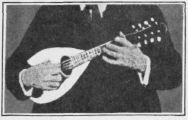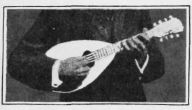Mandolin Self Instructor, online tutorial - Page 11
A simplified self learning system for the Mandolin with tuning instruction, song folio, chord diagrams, sheet music and PDF for printing. By ZARH MYRON BICKFORD
| Share page | Visit Us On FB |
|
HOLDING THE INSTRUMENT |
|||
 |
The manner of holding the mandolin when seated is here illustrated.
This position is usually preferable and is practically necessary when a violin or flat model instrument is used. The right knee may be crossed over the left, though this is not absolutely
necessary. If a bowl-shaped instrument is used, the back or ribs must be placed close to the body, well to the right side and with the top or face of the instrument very nearly perpendicular. The lower edge may be brought out slightly, if desired, so that the fin-
gerboard can be seen. The left hand and neck of the instrument should be elevated slightly, |
||
|
as shown in the cut, but too much of an angle is not advised.
It will be found an excellent rule to hold the instrument so that from the tenth to the twelfth fret comes directly
in the center of the body of the performer. The left hand must be brought well back, so that it is practically in a straight ilne with the right hand when in playing position, and so that the instrument is exactly parallel to the body. These rules must be carefully followed, as they are essential to the best results. If the violin or flat model is used, the lower edge should be brought still farther forward so that the back of the in- strument does not rest flat against the body. In all other respects both styles are held in exactly the same manner. |
|||
 |
THE STANDING POSITION
Many soloists prefer to use the standing position when playing in public. The correct manner of holding the instrument in this position is here shown. The general position is the same as when sitting, except that the back of the instrument must rest against the body just above the hip and the front of the instrument must be in a perpendicular position, with the upper edge brought slightly forward, if anything, in order that a firm grip may be had. As stated above, it is not practicable to play the flat model in a standing position, although it could be done with the aid of a cord around the neck. |
||
|
THE LEFT HAND AND ARM
Since the left hand plays such an important part, both in the holding of the mandolin, as well as in playing, parti-
cular attention must be paid to its correct position. This hand should never grasp the neck of the instrument. On the contrary, the neck lays easily just above the third (knuckle) joint of the first finger (never below it), while
the side of the thumb, midway between the end and the first joint, is brought against the opposite side of the neck. It cannot be stated too strongly that the thumb must always remain straight at the first joint, being bent backwards
rather than in toward the fingers. The tip of the thumb (when the hand is in the first position) should be in a line with the first fret. When playing
on the first two strings, the tip of the thumb will barely show above the edge of the fingerboard and the ball or fleshy cushion will rest against the neck, but when the fingers are brought over to the third and fourth strings, the thumb turns slightly so that the side, near the corner of the nail, is the only part that touches, while the tip drops down to a point from the level of the fingerboard to a quarter inch below, depending on the length of the thumb. This slight change in the position of the thumb is caused by the fact that it is necessary to turn the hand when playing on the third and fourth strings so that the base of the fingers and the palm come very close to the fingerboard. The lower edge of the fingerboacd must touch the first finger at a point very near the second joint, which means that the knuckle joint is brought well under the neck, thus supporting instead of grasping it. The wrist must never be bent inwards, but forms a straight line from the elbow to the knuckle joints, with the single
exception that when playing on the fourth string, it is frequently necessary to curve the wrist slightly outwards—the same being true in certain chord positions which will be encountered. The arm must hang naturally by the side of the body, it never being necessary to throw the elbow out from the side. |
|||